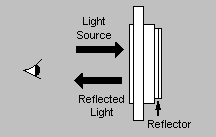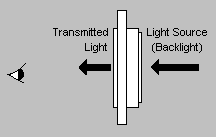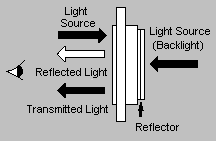
LCD Viewing Modes & Polarizers
Each part number for Pacific Display Devices require that the Liquid Crystal Display Viewing
mode and Polarizers be defined. The following section on Viewing Modes
and Polarizers will explain how the basic Liquid Crystal Display will appear
with the
Operating Mode selected.
![]() LCD Viewing Modes
LCD Viewing Modes
The type of image the display will create
is a cosmetic issue the engineering and marketing department work out. This
is the easiest choice since there are only two basic selections, and we will
go over each of them and what they mean:
POSITIVE IMAGE
A
positive image on an LCD display is when the pixel is "OFF" it is
transparent, when a pixel in "ON" it is opaque. On almost all displays the
image is smaller than the background, so this mode of operation is favored
in an application where ambient light is high and it will help with the
contrast of the display, especially for a display utilizing a Reflective
rear polarizer. An example would be a alpha-numeric character on a
larger background. The segments or dots on the character would absorb
light (appearing dark) and the background (the larger area) would reflect
light enhancing the characters. Here are several typical Operational
Mode & Viewing Mode combinations and the resulting images (assuming no
backlighting which can color the background):
TN: Black characters on a Gray background
STN-Green: Dark Violet / Black characters on a
Green background.
STN-Silver: Dark Blue / Black characters on a Silver
background
FSTN: Black characters on a White / Gray
background
NEGATIVE IMAGE
A
negative image on an LCD display is when the pixel is "OFF" it is opaque,
when a pixel in "ON" it is transparent. Since the image area is typically
smaller than the background, the portion of the display that could reflect
light and give the characters definition in this mode is minimized.
Therefore, this mode is typically only used when there is a backlight and
the ambient lighting conditions are medium to dim. Using a backlight, the
transparent segments of the display will "glow" because the backlight will
be viewable only when the pixels are turned on. A high ambient light
condition could wash out the backlight. Here are several typical
Operational Mode & Viewing Mode combinations and the resulting images
(assuming a backlight with the specified coloration listed):
TN: Glowing Green-Yellow characters
on a light Gray background (Green-Yellow Backlight)
STN ("Blue-Negative"): Glowing Green-Yellow
characters on an light Blue background (Green-Yellow
Backlight)
FSTN: Glowing White characters on a Black
background (White Backlight)
![]() LCD Polarizers
LCD Polarizers
Each LCD has 2 polarizers, the front and
rear polarizers, applied accordingly across the front of the display viewing
surface and across the rear of the display to determine how the infuse light
into the display. The front polarizer is always Transmissive and not
selectable by the user, however the rear polarizer has 3 choices and two
grades for each choice. The rear polarizer selection is as follows:
REFLECTIVE POLARIZER
 Reflective
displays have an opaque rear polarizer that includes a diffuse reflector,
such as brushed aluminum. This layer reflects polarized ambient light that
has entered the front of the display back trough the LCD cell. Reflective
displays require ambient light to be seen. They exhibit high brightness,
excellent contrast, and wide viewing angles. They are particularly suitable
for use in battery operated equipment where an adequate level of light is
always available. Reflective LCD's cannot be backlit, however they can be
front lighted in some applications.
Reflective
displays have an opaque rear polarizer that includes a diffuse reflector,
such as brushed aluminum. This layer reflects polarized ambient light that
has entered the front of the display back trough the LCD cell. Reflective
displays require ambient light to be seen. They exhibit high brightness,
excellent contrast, and wide viewing angles. They are particularly suitable
for use in battery operated equipment where an adequate level of light is
always available. Reflective LCD's cannot be backlit, however they can be
front lighted in some applications.
TRANSMISSIVE POLARIZER
 Transmissive
displays have a clear polarizer on the front and the back. The display
therefore depends on light coming through from the back of the display
toward the observer in order to be seen. Most, but not all transmissive
displays are negative image, and we sometimes add colored filters to
different areas of the display to highlight different annunciators.
Another example of a transmissive polarizer display would be a transparent
window where you could see the segments superimposed over your line of
vision through the display window (this assumes a sufficient ambient light
source exists on either side of the window).
Transmissive
displays have a clear polarizer on the front and the back. The display
therefore depends on light coming through from the back of the display
toward the observer in order to be seen. Most, but not all transmissive
displays are negative image, and we sometimes add colored filters to
different areas of the display to highlight different annunciators.
Another example of a transmissive polarizer display would be a transparent
window where you could see the segments superimposed over your line of
vision through the display window (this assumes a sufficient ambient light
source exists on either side of the window).
TRANSFLECTIVE POLARIZER
 Transflective
displays have a rear polarizer which includes a translucent material which
reflects part of the ambient light, and also transmits backlighting. As the
name implies, it is a compromise between the transmissive and reflective
viewing mode. Used in reflection, it is not as bright and has lower contrast
than the reflective type LCD, but it can be backlit for use in low light
conditions. This polarizer is the best selection for a
display that can be used in all lighting conditions with a backlight.
Transflective
displays have a rear polarizer which includes a translucent material which
reflects part of the ambient light, and also transmits backlighting. As the
name implies, it is a compromise between the transmissive and reflective
viewing mode. Used in reflection, it is not as bright and has lower contrast
than the reflective type LCD, but it can be backlit for use in low light
conditions. This polarizer is the best selection for a
display that can be used in all lighting conditions with a backlight.
COMMERCIAL GRADE POLARIZER
The grade of a polarizer determines its operational and
storage temperature range. The commercial grade polarizer operates
typically between -10°C to +60°C.
INDUSTRIAL GRADE
POLARIZER
The grade of a polarizer determines its operational and
storage temperature range. The industrial grade polarizer operates
typically between -30°C to +80°C. Other temperature ranges are also
available.